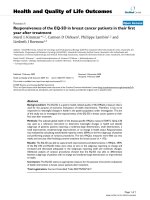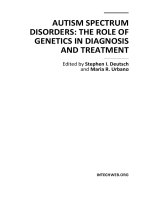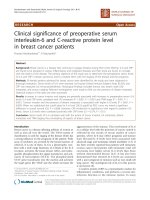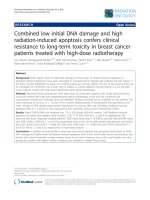The role of 18FDG PET/CT in diagnosis of stage, recurrence, metastases in breast cancer patients pre and post treatment
Bạn đang xem bản rút gọn của tài liệu. Xem và tải ngay bản đầy đủ của tài liệu tại đây (82.62 KB, 7 trang )
Jourrnal of military pharmaco-medicine n09-2019
THE ROLE OF 18FDG PET/CT IN DIAGNOSIS OF STAGE,
RECURRENCE, METASTASES IN BREAST CANCER
PATIENTS PRE- AND POST-TREATMENT
Nguyen Trong Son1; Nguyen Danh Thanh2
SUMMARY
Objectives: To evaluate the role of PET/CT in staging diagnosis in pre-treatment breast
cancer patients and finding recurrence lesions, metastases in post-treatment breast cancer
patients. Subjects and methods: 55 pre-treatment breast cancer patients were performed
18
FDG PET/CT for initial staging diagnosis and 98 breast cancer patients underwent
mastectomy, radiotherapy and/or chemotherapy with clinical symptoms or radiologic findings or
18
rising levels of tumor markers (CA15.3; CEA) had been performed FDG PET/CT to assess the
18
recurrence, metastases. Results: FDG PET/CT gave result of increased stage in 21/55
patients (38.2%) included: 15/40 patients (37.5%) in stage II and 6/11 patients (54.5%) in stage
III. There was no change in patients with stage I. These results also changed treatment of
18
choice in 9/55 patients (16.4%). In 98 post-treatment patients, FDG PET/CT detected lymph
nodes with increased SUVmax in 34/98 patients (34.7%), detected recurrence and distance
metastases in 54 patients (55.1%): 12 patients had local recurrence (12.3%), of which 2 patients
with local recurrence and distance metastases. Bone metastases rate was 22.5%; lung
metastases rate was 20.4%; thoracic wall metastases rate was 8.2%; hepatic metastases rate
18
was 8.2% and other metastases rate was 7.1%. Conclusion: FDG PET/CT scan effectively
detected axillary and extraaxilary nodes, distance metastases, it had great value in stage
diagnosis for pre-treatment breast cancer and for following-up, detection of recurrent and
metastases in post-treatment breast cancer patients.
18
* Keywords: Metastatic breast cancer; Recurrence; FDG PET/CT.
INTRODUCTION
The diagnosis of breast cancer is based
on clinical symptoms, histology and diagnosis
imaging such as mammography, ultrasound,
computed tomography scan (CT-scan)
and magnetic resonance imaging (MRI).
Positron emission tomography/computed
tomography with fluorine-18-fluorodeoxyglucose (18FDG PET/CT) can detect
early changes of metabolic shift of disease,
even before physiological and anatomical
changes. In patients with breast cancer,
18
FDG PET/CT had been demonstrated in
accurate diagnosis of tumor location,
allows to find axillary and extraaxillary
lymphatic node (upper and lower clavicular
nodes, inner mammary nodes), thoracic
and abdominal metastases, bone metastases,
so it can help to evaluate pre-treatment
breast cancer stage.
1. Viet Duc Hospital
2. 103 Military Hospital
Corresponding author: Nguyen Trong Son ()
Date received: 01/10/2019
Date accepted: 27/11/2019
299
Jourrnal of military pharmaco-medicine n09-2019
18
FDG PET/CT also has high accuracy
rate, sensitivity (Se) and specificity (Sp) in
follow up scan to find post-treatment
recurrence and metastases. Especially
when patient with clinical symptoms of
recurrence or high serum concentration of
tumor markers but has no abnormal sign
in other conventional imaging method, or
even when patient has no clinical symptoms.
In Vietnam, nowadays, it had a few
studies about value of 18FDG PET/CT in
patients with breast cancer. However, this
is not yet a systematic, fully documented
about stage diagnosis value of 18FDG
PET/CT.
Therefore, this study was carried out
with following objectives: To evaluate the
role of 18FDG PET/CT in staging diagnosis
in pre-treatment breast cancer patients
and for finding recurrence lesions, metastases
in post-treatment breast cancer patients.
SUBJECTS AND METHODS
1. Subjects.
- Group 1: 55 patients diagnosed with
breast cancer by histopathology were
underwent 18FDG PET/CT scan for pretreatment staging diagnosis. Patients'
staging according to TNM classification of
American Joint Committee on Cancer (AJCC)
(2017) based on clinical examinations,
CT-scan and MRI.
- Group 2: 98 post-treatments (mastectomy
+/- radiotherapy +/- chemotherapy) breast
cancer patients, underwent 18FDG PET/CT
or patients had clinical symptoms, with
recurrence lesions and metastases detected
on other conventional imaging methods or
with high tumor markers concentrations
300
(CEA, CA15.3) or to post-treatment followup patients.
2. Methods.
- Study design: Non-control prospective
clinical study, cross-sectional description
with convenience sampling.
- 18FDG PET/CT was processed according
to American College of Radiology (ACR)
and European Association of Nuclear
Medicine (EANM) guidelines [1, 2].
- 18FDG was produced in Cyclotron
Center of 108 Military Central Hospital.
Used dose: 0.15 mCi/kg (5.55 MBq/kg);
injected through venous system 45
minutes before scan process.
- PET/CT system: GE PET/CT Discovery
ST4 system, Siemens PET/CT Biograph
6 True Point system and GE PET/CT
Discovery IQ system.
The results were analyzed by both
nuclear medicine doctors and radiologists:
Identified lesions (tumor, lymph node,
distance metastases) with increased
18
FDG uptake on PET/CT (SUVmax > 2,5).
The staging of patients was compared
between pre- and post-FDG PET/CT scan.
In post-treatment cancer patient group,
18
FDG PET/CT was performed after last
treatment at least 3 months to eliminate
false positive due to inflammatory after
treatments.
RESULTS AND DISCUSSION
1. The role of 18FDG PET/CT in staging
breast cancer.
Before 18FDG PET/CT scan, the almost
of breast cancer patients were at T 1
and T2 stage (85.5%). 14.5% of patients
had a large breast tumor with invasion to
the skin, chest wall. 43.6% of patients
Jourrnal of military pharmaco-medicine n09-2019
detected lymph nodes, of which N1 in
34.5% of patients and N2 - N3 in 9.1% of
patients. Stage I was in 7.3% of patients
and stage II accounted for the majority
(72.7%), stages IIIB and IIIC were 20.0%.
On 18FDG PET/CT detected primary
tumors in 55/55 patients (100%); tumor
size 0.7 - 7.6 cm; average tumor size was
2.87 ± 1.46 cm.
36/55 patients (65.5%) were found
lymph node (axillary lymph nodes, inner
mammary, supraclavicular nodes...) with
the total number of 70 lymph nodes.
Distance metastases in the study
group were found in 9/55 patients
(16.4%), including 2 patients with lung
metastases, 2 patients with bone
metastases, 2 patients with metastases
from contralateral breast, 3 patients with
both bone metastases and lung metastases.
Of the 9 patients with metastases detected,
4/40 patients (10.0%) were in stage II and
5/11 patients (45.5%) were in stage III
before 18FDG PET/CT. No patients with
stage I before 18FDG PET/CT were detected
distance metastases.
Table 1: Change of N stage diagnosis after 18FDG PET/CT.
Before
18
FDG PET/CT
After
18
FDG PET/CT
N
Number of patients
N0
N1
N2
N3
N0
31
18
9
2
2
N1
19
1
16
-
2
N2
2
-
1
1
N3
3
-
-
1
2
55
19
25
4
7
Total
The number of patients with lymph node-negative (N0) decreased, and the number
of patients with lymph node N1 and N3 increased due to the detection of additional
lymph nodes in the 18FDG PET/CT image. 18FDG PET/CT changed the diagnosis of
lymph node stage in 18/55 patients (32.7%), of which 16/55 patients (29.1%) had upstage and 2/55 patients (3,6%) with reduction stage.
Table 2: Change of TNM stage diagnosis after 18FDG PET/CT.
Before PET/CT
Stage TNM after
18
FDG PET/CT
Number of patients
I
IIA
IIB
IIIA
IIIB
IIIC
IV
I
4
4
-
-
-
-
-
-
IIA
24
1
13
6
1
1
2
IIB
16
-
1
10
2
1
2
IIIA
0
IIIB
8
-
-
-
-
4
1
3
IIIC
3
-
-
-
-
-
1
2
IV
0
Stage
Total
55
0
0
5
14
16
7
4
9
301
Jourrnal of military pharmaco-medicine n09-2019
- 4 patients with stage I did not change
diagnosis after PET/CT.
- 24 patients with stage IIA before
FDG PET/CT, after 18FDG PET/CT had
stage changes in 11/24 patients (45.8%), of
which 1 patient from T2 to T1 (tumor size
was 1.4 cm) changed from IIA to IA and
10 patients (41.7%) increased the stage,
including:
18
+ 2 patients changed to stage IV:
1 patient with lung metastases and 1 patient
with contralateral side metastases.
+ 6 patients with axillary lymph nodes
changed to stage IIB.
+ 3 patients changed to stage IV:
1 patient with lung metastases; 2 patients
with lung and bone metastases.
+ 1 patient found subclavicular node,
changed from N2 to N3 and stage from IIIB
to IIIC.
- 2 patients with stage IIIC before 18FDG
PET/CT, after
18
FDG PET/CT detected
1 patient with lung metastases and bone
metastases; 1 patient with multifocal bone
metastases. Both cases were in stage IV
after 18FDG PET/CT.
After
18
FDG
PET/CT,
there
were
+ 1 patient with carina lymph nodes
changed to stage IIIC.
21/55 patients (38.2%) with up-stage,
+ 1 patient with invasive chest wall
changed to stage IIIB.
The rate of up-stage in patients with stage
2/55 patients (3.6%) with reduction stage.
II before PET/CT was 37.5% and in stage
- 16 patients with stage IIB before 18FDG
PET/CT, after 18FDG PET/CT changed
stage in 6/16 patients (37.5%), including
1 patient from T2 to T1c and so from IIB to
IIA stage, other 5 patients (31.2%) increased
the stage, including:
III before PET/CT was 54.5%. 4 patients
+ 2 patients changed to stage IV: 1 patient
with opposite side metastases and 1 patient
with multifocal bone metastases.
over other imaging methods in detecting
+ 2 patients had invasive skin + chest
wall, from T2 to T4 and so that they changed
to stage IIIB.
metastases. 18FDG PET/CT had low sensitivity
+ 1 patient found carina lymph node,
changed to stage IIIC.
cancer (T4d) or local advanced breast
- 8 patients with stage IIIB before
FDG PET/CT, after 18 FDG PET/CT,
there were 4/8 patients (50%) with stage
changes:
18
302
from stage II and 5 patients from stage III
were found metastases and changed to
stage IV, so that they had to change the
primary treatment method (16.4%).
18
FDG PET/CT showed advantages
lymph nodes like supraclavical nodes,
inner mammary nodes, lung and bone
with brain metastases. In patients with
high risk such as inflammatory type breast
cancer,
18
FDG PET/CT had high value
in detecting distance metastases. Other
study also showed the role of 18FDG PET/CT
with breast cancer stage IIB (T2N1/T3N0)
[3, 4].
Jourrnal of military pharmaco-medicine n09-2019
2. The role of 18FDG PET/CT in
detecting recurrence and distance
metastases in post-treatment patients.
Local recurrence or distance metastases
occur in post-treatment patients. Each
year, there are more 2 million new breast
cancer patients and more than 30% of
breast cancer patients have local recurrence
or distance metastases in 15 years after
treatments [5, 6].
In the group of 98 post-treatment
cancer patients, 54.1% of patients had
18
FDG PET/CT scan to evaluate and
detect metastatic recurrence. The remaining
(45.9%) took 18FDG PET/CT scan because
of signs of relapse, metastasis on conventional
imaging diagnosis (CT, ultrasound, MRI)
and/or CA15.3 marker increased > 25 U/mL.
Before 18FDG PET/CT, clinically and/or
by conventional imaging diagnostics (CT,
ultrasound, MRI, radiography...) detected
distance metastases in 17/98 patients
(17.3%). Most common were bone
metastases: 10/98 patients (10.2%) and
lung metastases 4/98 patients (4.1%). On
the ultrasound also detected axillary
nodes in 3 patients and supraclavicular
node in 1 patient; 2 patients had local
recurrence lesions.
18
FDG PET/CT scan detected lymph
nodes in 34/98 patients (34.7%). The
number of increased uptake 18FDG lymph
node detected in each patient 1 - 6 nodes,
the total number of lymph nodes detected
in 34 patients was 82. The most common
was mediastinal lymph nodes (34/82 patients),
followed by axillary lymph nodes...
Table 3: Detected recurrent and
metastases on 18FDG PET/CT in posttreatment breast cancer patients.
Number of
patients
Rate
(%)
Lung
20
20.4
Bone
22
22.5
Liver
8
8.2
Soft tissue
8
8.2
Brain
1
1.0
Other
7
7.1
12
12.3
Location
Distance
metastases
Recurrence
18
FDG PET/CT detected distance
metastatic lesions in 17/17 patients (100%),
which were detected on conventional
imaging and detected further metastatic
lesions in 27 other post-treatment breast
cancer patients. The total number of
detected distance metastases was
44/98 patients (44.9%). The most were
bone metastases and lung metastases;
17 patients with metastatic lesions of 2 or
more organs. 12 patients had a relapse.
A total of 78 recurrent lesions and distance
metastases were detected in 54 patients.
Distance metastases due to breast
cancer after treatment were found much
in lungs and bones. Brain metastases
were detected only when the tumor size
was large and the level of 18FDG uptake
was high.
And besides, recurrence lesions were
detected in 12/98 patients (12.3%). In those
patients, there were 2 patients had both
local recurrence and distance metastases.
303
Jourrnal of military pharmaco-medicine n09-2019
Table 4: The recurrence or metastases detected on 18FDG PET/CT according to the
indicative group.
Number of
patients
Patients with
recurrent or
metastases
Rate (%)
Evaluated post-treatment
53
19
35.8
Recurrence and metastases on CT, ultrasound, MRI
13
13
100
Recurrence, metastases on CT, ultrasound, MRI and
increased CA15.3
12
11
Increased CA15.3 (> 25 U/mL)
20
11
55.0
98
54
55.1
Reason for indicating
post-treatment
18
FDG PET/CT
Total
Patients with suspected recurrence
and distance metastases were detected
on 18FDG PET/CT with recurrent or distance
metastases. The rate of recurrence and
distance metastases in the group suspected
of recurrence through conventional imaging
diagnosis and increased serum CA15.3
was 11/12 patients (91.7%) and the group
with high serum CA15.3 was 22/32 (68.7%).
Early and accurate detection of recurrence
and metastases lesions in breast cancer
patients has high value in re-staging and
choosing treatments. Local recurrence
can be treated with surgery or radiotherapy;
distance metastases can be treated with
chemotherapy or palliative care. PET/CT
is an effective whole body imaging methods
for detecting recurrence, metastases in
cancer in general and breast cancer in
particular with accuracy above 90% [7, 8].
PET/CT has advantages in diagnosis
of recurrence lesions over other imaging
methods with higher sensitivity and specificity,
especially in patients have high concentration
of serum tumor marker. In patients without
clinical symptoms but have high biomarker,
18
FDG PET/CT can detect metastases
304
91.7
with accuracy up to 87 - 90% while other
imaging methods only have accuracy
about 50 - 78%.
General guidelines recommend posttreatment 18FDG PET/CT scan in patient
with pre-treatment stage from II to IIIB,
and patient with inflammatory breast cancer.
Because in these groups, metastases can
be detected with the highest rate and
thought changing the treatment of choice.
In our study, 18FDG PET/CT detected
all metastases that were already detected
on other methods.
CONCLUSIONS
18
FDG PET/CT could detect primary
tumor in 100% of breast cancer patients,
with size 1.1 - 7.6 cm; detected lymph
nodes in 36/55 patients (65.5%) with total
of 70 nodes, size from 0.5 - 2.4 cm;
detected
distance metastases
in
9/55 patients: 2 patients (3.6%) with lung
metastases, 3 patients (5.5%) with lung
and bone metastases, 2 patients (3.6%)
with bone metastases and 2 patients
(3.6%) with contralateral side metastases.
Jourrnal of military pharmaco-medicine n09-2019
Compare to clinical based and other
methods based cancer stage, 18FDG PET/CT
gave result of increased stage in
21/55
patients
(38.2%)
included:
15/40 patients (37.5%) in stage II and
6/11 patients (54.5%) in stage III. There
was no change in patients with stage I.
These results helped to change treatment
of choice in 9/55 patients (16.4%).
In 98 post-treatment patients, 18FDG
PET/CT detected lymph nodes with increased
SUVmax in 34/98 patients (34.7%) with total
of 82 nodes. 18FDG PET/CT also detected
recurrence and distance metastases in 54
patients (55.1%): 12 patients had local
recurrence (12.3%); 2 patients with local
recurrence and distance metastases.
Bone metastases rate was 22.5%; lung
metastases rate was 20.4%; thoracic wall
metastases rate was 8.2%; hepatic
metastases rate was 8.2% and other
metastases rate was 7.1%. 17 patients
(17.3%) had metastases in at least 2 organs.
In post-treatment follow up group,
13/53 patients (24.5%) had metastases
lymph nodes with increased SUVmax and
19/53 patients (35.8%) had recurrence or
distance metastases. In patients with
increased CA15.3, 16/32 patients (50%)
had metastases lymph nodes and
22/32 patients (68.7%) had recurrence and
distance metastases.
REFERENCES
1. ACR. ACR-SPR practice parameter for
perfoming 18FDG PET/CT in oncology. Resolution.
2016, 25, pp.1-9.
2. 18FDG PET/CT. EANM procedure guideline
for tumour imaging: Version 2.0. Eur J Nucl
Med Mol Imaging. 2015, 42, pp.328-354.
3. Segaert I, Mortaghy R. Additional value
of PET/CT in staging of clinical stage IIB
and III breast cancer. Breast J. 2010, 16,
pp.617-662.
4. Lebon V, Alberini J.L, Pierga J.Y. Rate
of distant metastases on 18FDG PET/CT at
initial staging of breast cancer: Comparison
of women younger and older than 40 years.
J Nucl Med. 2017, 58, pp.252-257.
5. Cochet A, David S, Moodie K et al.
The utility of 18FDG PET/CT for suspected
recurrent breast cancer: Impact and prognostic
stratification. Cancer Imaging. 2014, 14, p.13.
6. Piva R, Ticconi F, Ceriani V. Comparative
diagnostic accuracy of FDG PET/CT for
breast cancer recurrence. Breast Cancer Targets and Therapy. 2017, 9, pp.461-471.
7. Gaeta C.M, Sher A.C, Kohan A et al.
Recurrent and metastatic breast cancer PET,
PET/CT, PET/MRI: FDG and new biomarkers.
The Quarterly J of Nucl Med and Mol Imaging.
2013, 57, pp.352-366.
305









